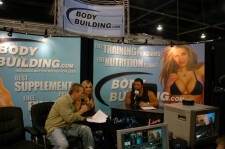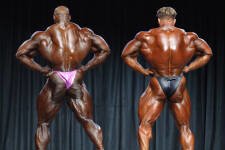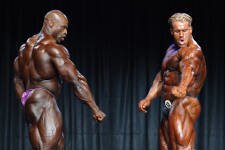Up until this fateful morning I had been fortunate enough to have never broken anything in my body, I hadn't even needed a stitch. I'd scraped through my early years with no scars to show.
This all changed when I was cycling to work one October morning.
I had been making some great progress with my training, it was still the off-season for me and I had been my strongest ever and still was pretty lean compared to other off-season times where I had ballooned up.
All in all, I was feeling real good about how I was moving in the right direction and had set my sights on a competition the following April, a natural show with the SNBF federation in Atlanta.
The Accident
I was working as a personal trainer at a local gym and like I had hundreds of times before I was cycling to work, unfortunately for me the road I was cycling on had just started to be worked on, getting re-laid making it very uneven, with gravel and pot holes everywhere.
Sadly, the local government seems to think that when a road is half complete it is acceptable to open it. Atlanta is not a very cyclist friendly city you see.
The next events of my front tire striking an uneven ridge in the road while I was going downhill sending me over the handlebars crashing into the road has replayed in my mind a thousand times.
Immediately I knew I had seriously hurt myself. I jumped up instinctively as I didn't want to lie on the ground and felt my right collarbone, which now had a massive lump sticking out of it; luckily the bone had not broken the skin.
I was about two minutes from work and didn't have a cell phone on me, so I just jumped back on the bike and set my mind on getting to work so I could call an ambulance.
As I arrived at work the pain started to set in and I barely made it to the front desk to explain I'd been in an accident and need to go to hospital.
Next thing I know, I'm sitting on a chair and can hear voices around me but cannot see anything even though my eyes are open, now that started freaking me out a little!
After about 10 minutes my sight started coming back, (I had taken a knock to the head too, smashing my helmet, thank god I was wearing one!). Finally, the ambulance arrived and took me away.
At the hospital they filled me with morphine, which just made me sick rather than kill the pain, and did the x-rays. My collarbone had been broken so badly that it wouldn't repair itself.
One bone had gone up and the other down. This meant that I would have to have surgery and have a plate and pins put around my collarbone to put it back together.
Still Going To The Olympia Though...
Not only was I upset about this but I was gutted as I was going to Vegas in three weeks to see the Mr. Olympia, I had my flights and tickets already booked. My surgery was booked for two weeks later as they wanted the swelling to go down before they operated.
The next two weeks every step I took I could feel the bones move around which was really uncomfortable. However, the pain after the surgery was far worse.
My surgery went smoothly, and I was in and out fast, actually really fast, the hospital was so busy they were kicking me out just one hour after surgery even though I was still throwing up from the anesthetic and could barely move due to the discomfort.
The nurses had forgotten to give me painkillers when I awoke! This set my wife off on them for being so careless. I was told by others that the pain post-surgery is the worst part, so I was half expecting it, but feeling excruciating pain while not even moving was still a shock to the system.
I didn't take many painkillers, as all they did was make me feel nauseous. Plus, having to sleep sitting upright wasn't easy and led to me only getting 4 hours sleep a night if I was lucky. Throughout, the whole time I only took 4 days off work.
I felt so uncomfortable anyway so I figured I might still get paid for training people. Luckily, my clients were great and would drive me to and from the gym and all I would do is direct them through their workouts.
I still made it to see the Olympia as well, and I am glad I did, especially when Ronnie Coleman came on stage at 287 pounds and blew everyone away. That was truly a special experience.
What'll Happen To My Muscle Size?
I knew from the start to expect some muscle loss in my right arm due to it being completely immobilized. However, I wasn't prepared for how rapid the deterioration was.
My right arm muscle was shrinking fast. I was able to do grip squeezes on a tennis ball, but that was it.
Unfortunately, my whole right side took a hit with my delts and chest atrophying as well.
I was really good on my nutrition; I was eating healthy and taking in protein drinks. But, naturally my appetite was down I and had lost about 15 pounds in a few months (some way to lose weight, huh?).
I also made sure to take in extra supplements to help with the bones reforming, Glucosamine and Chondroitin, and extra calcium.
Plus, as I wanted to keep my immune system up during this recovery period, I also added anti-oxidants such as vitamin C, E, beta-carotene and L-Glutamine.
Frozen Shoulder, An Icy Situation!
I encountered a massive setback when my stitches opened up and were unable to be resealed due to risk of infection.
This meant that I basically had an open wound were the surgery was and every day my wife had to 'pack' the wound with dressing and clean it to prevent infections.
This was a real problem as now the wound was going to have to heal itself from the inside out; this process was going to take a very long time (3 months in fact!).
The result was that I was not allowed to move my arm at all until the surgery site healed sufficiently, extending my recovery period from the initial 6-8 weeks to well over 3-4 months. I couldn't believe it!
Not only did it mean that I would not be able to train for ages, but I would also be left with a very big scar on my right shoulder, quite an ugly one too as it is sunken rather than smooth and is both wide and long.
(When I was in Australia in the past year, one person actually asked if a small shark had bitten me due to appearance! Obviously, being macho I said yes!)
A further setback of having my arm immobile for so long was developing frozen shoulder. This is when the shoulder capsule tightens up and it feels like you have cement in your shoulder socket, as you're unable to move your arm no matter how hard you try.
Training Throughout My Recovery Period
While waiting for the wound to heal, I couldn't sit back and not train at all. It was driving me crazy. There is only so many Battle for the Olympia tapes you can watch while in recovery, I just wanted to get back into doing some training, no matter what it was.
Within the first two weeks of surgery, I was back doing cardio. I would do the step master, I'd go slow and hands free and worked back up to 30 minutes non-stop.
Also, I would do the stationary bike, just sitting upright using my free arm to cradle to right arm strapped to me to help prevent too much movement in it. Later on I also included the Elliptical Cross-Trainer.
I had read up on uni-lateral training. Some studies had shown that when you have suffered one broken limb, by training your good side you can help prevent too much deterioration in the broken side.
I was not sure if this was going to work or not, but I was more than willing to give it a try. Plus, the training of my good side would help maintain that until I was able to go full-out again.
My training routine would be an Upper/Lower body split. Training with weights 4 times a week.
I was still able to train legs pretty good, it was a little uncomfortable not being able to brace yourself while doing leg extension and seated leg curls.
I made up for this, however, by lightening the weight and using strict form and also doing my reps in a 1½ rep manner, this is were I do one full rep then only go half of the way back, pausing, then taking it back to contraction again before returning to the start. Talk about burn!
This helped to keep the intensity in there, without having to worry about the weights being lighter. Some of my friends at the gym would load the leg press for me and I would get some good sets in there.
Upper body was more interesting and took a lot of focus to execute without causing pain in my right shoulder. This is where Iso-Hammer machines really came in handy.
Upper Body Recovery Training Routine
My unilateral upper body routine was as follows (all done on left side only):
- Iso-Hammer Chest Seated Bench Press: 3 sets, 10-15 reps, superset with:
Iso-Hammer High Row Pull-down: 3 sets, 10-15 reps
- Incline Dumbbell Press: 3 sets 10-15 reps, superset with:
Hammer Seated One-Arm Row: 3 sets, 10-15 reps
- Dumbbell Lateral: 3 sets, 10-15 reps, tri-set with:
One-Arm Hammer Preacher Curl: 3 sets, 10-15 reps
One-Arm Hammer Triceps Extension: 3 sets, 10-15 reps
 Click Here For A Printable Log Of Unilateral Upper Body Routine.
Click Here For A Printable Log Of Unilateral Upper Body Routine.
Even though the weights were light, it felt good just to be lifting again and breaking a sweat in the gym.
Breaking Through The Ice
Finally my surgery site healed enough that I was told I could start getting rehab on my shoulder and try to make it move again. It is the strangest thing when you want your arm to move and you can only lift it about 6 inches high and about the same the side.
Luckily, one of my colleagues at the gym is a physiotherapist and he gave me some exercises to do 4-5 times a day to work the range of motion back.
These consisted of bending over and letting the arm hang down and making small controlled circles attempting to increase the circle size.
Also, using the good arm to support the bad arm in lifting it up and to the sides, sounds very simple and it is but when your shoulder is stuck in one position the pain is pretty intense when you push it sticking position.
Many people with frozen shoulders resort to going into hospital and going under and then when asleep the doctors will break the cement like build up in the shoulder by forcefully moving it into all different areas.
This can be very painful when you wake up, and also due to the force the doctor need to apply, you can have your shoulder dislocated! Neither of which was I keen on going through.
So I saw my physio every week where he would work on increasing my range of motion by stretching out my shoulder and using his weight to push it to levels which you are unable to manage by yourself.
"Talk about Pain City! But it worked,
and I was rapidly getting my arm to work again."
By January, I started to work on my right side with weights to gain strength back. I was expecting to be weak, but I was floored when I struggled to do a seated bench press with just one plate!
I would get some strange looks when I was straining with weights that even the pensioners in the gym would find light. But I didn't care, I just focused on one thing, getting back to normal and then being able to lift more weights than I did before my injury.
My stability in my shoulder was zero, trying to do a Dumbbell Bench Press with a 20 pound dumbbell was a challenge and it would wobble all over the place. Still undeterred, I was happy to be finally feeling iron in the hands again.
Thank God For Muscle Memory
I took my measurements when I started training with weights again. My right arm was so atrophied that it when flexed it made little difference to the tape. However, as soon as I started training, my whole right side started filling out again. It was quite fun to see the arm getting bigger week after week, it reminded me of when I first started training and had that initial growth spurt that you get when you're 15 and full of teenage testosterone.
Within four months, by May, I was back to about 90% of my strength and feeling good. I maintained an upper/lower body split, of a 2-on 1-off system. I used different exercises in every session to hit the muscle from different angles and let the body re-learn the differing exercises again.
I could do pretty much every exercise without discomfort, which was excellent as one of my doctors told me that I wouldn't be able to squat or do shrugs again due to having the plate in my shoulder. I didn't believe him then and never let his lack of knowledge in the weight room stand in the way of me getting back to what I love.
I did have to make some allowances for my injury, though. My shoulders were now asymmetrical and this meant that exercises such as Bench Press and Dips caused me to not perform the exercise correctly. My right shoulder wouldn't work comfortably in this manner.
The solution was to use exclusively dumbbells for my upper body free weight workouts, this way the shoulders could move in their own preferred range of motion without causing pain. Plus, Hammer Strength machine and cables were used to complete out the routine design.
Looking Ahead
A year after the accident, apart from the big scar, my training was full bore and I was lifting heavier weight than I did prior to my bicycle fall. I incorporate rotator cuff work into my weight routine at least 2-3 times a week now to keep them strong and stable.
This helped significantly in being able to get back to using the barbell in my routine again, now I can do incline and decline bench without any problem (the flat bench still causes uncomfortable stress, however I always preferred the other versions anyway), and military presses are a firm favorite again.
One positive outcome of suffering an injury such as mine is that it does make you appreciate the good fortune of being able to lift and not take that for granted. Also, it pushes me in the gym to keep on improving and reaching a new level.
The past couple of years have been a challenge both mentally and physically, but staying focused on getting back to 100% and beyond helped me recover quickly.
I hope that no one reading this suffers an injury that causes such a setback as what I had, but if something unfortunate does happen, remember to keep positive, maintain your bodybuilding diet and supplement plan, and then fight to get yourself better!
Thanks for letting me share my recovery story with you, and I'm looking forward to stepping on-stage next year for the first time since the accident and being better than I was in my last competition.









